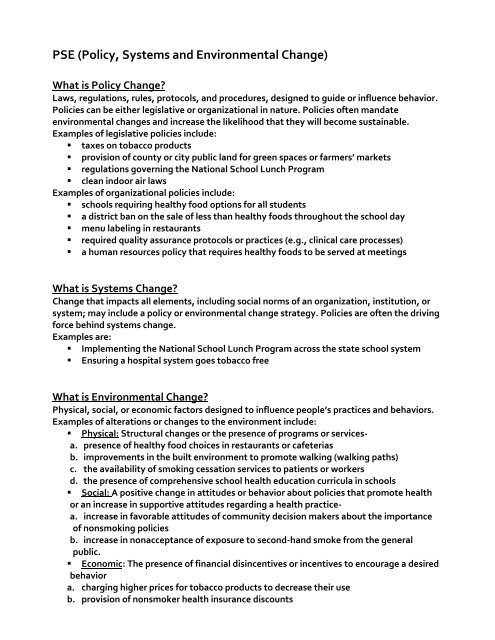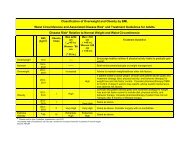Policy, Systems and Environmental Change
Policy, Systems and Environmental Change
Policy, Systems and Environmental Change
Create successful ePaper yourself
Turn your PDF publications into a flip-book with our unique Google optimized e-Paper software.
PSE (<strong>Policy</strong>, <strong>Systems</strong> <strong>and</strong> <strong>Environmental</strong> <strong>Change</strong>)<br />
What is <strong>Policy</strong> <strong>Change</strong><br />
Laws, regulations, rules, protocols, <strong>and</strong> procedures, designed to guide or influence behavior.<br />
Policies can be either legislative or organizational in nature. Policies often m<strong>and</strong>ate<br />
environmental changes <strong>and</strong> increase the likelihood that they will become sustainable.<br />
Examples of legislative policies include:<br />
• taxes on tobacco products<br />
• provision of county or city public l<strong>and</strong> for green spaces or farmers’ markets<br />
• regulations governing the National School Lunch Program<br />
• clean indoor air laws<br />
Examples of organizational policies include:<br />
• schools requiring healthy food options for all students<br />
• a district ban on the sale of less than healthy foods throughout the school day<br />
• menu labeling in restaurants<br />
• required quality assurance protocols or practices (e.g., clinical care processes)<br />
• a human resources policy that requires healthy foods to be served at meetings<br />
What is <strong>Systems</strong> <strong>Change</strong><br />
<strong>Change</strong> that impacts all elements, including social norms of an organization, institution, or<br />
system; may include a policy or environmental change strategy. Policies are often the driving<br />
force behind systems change.<br />
Examples are:<br />
• Implementing the National School Lunch Program across the state school system<br />
• Ensuring a hospital system goes tobacco free<br />
What is <strong>Environmental</strong> <strong>Change</strong><br />
Physical, social, or economic factors designed to influence people’s practices <strong>and</strong> behaviors.<br />
Examples of alterations or changes to the environment include:<br />
• Physical: Structural changes or the presence of programs or servicesa.<br />
presence of healthy food choices in restaurants or cafeterias<br />
b. improvements in the built environment to promote walking (walking paths)<br />
c. the availability of smoking cessation services to patients or workers<br />
d. the presence of comprehensive school health education curricula in schools<br />
• Social: A positive change in attitudes or behavior about policies that promote health<br />
or an increase in supportive attitudes regarding a health practicea.<br />
increase in favorable attitudes of community decision makers about the importance<br />
of nonsmoking policies<br />
b. increase in nonacceptance of exposure to second-h<strong>and</strong> smoke from the general<br />
public.<br />
• Economic: The presence of financial disincentives or incentives to encourage a desired<br />
behavior<br />
a. charging higher prices for tobacco products to decrease their use<br />
b. provision of nonsmoker health insurance discounts







